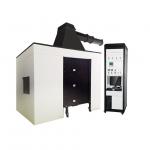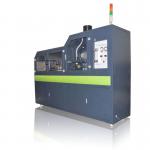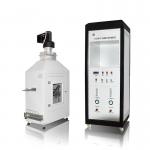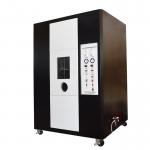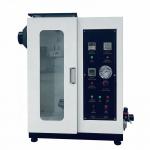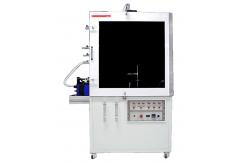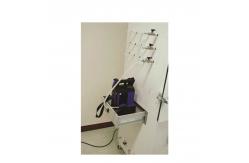In the context of naval safety and fire protection, the NES 713
Automatic Naval Smoke Toxicity Index Test Apparatus plays a crucial
role. It is designed to assess the toxicity levels of smoke
generated during fires in naval vessels, providing essential data
for ensuring the well-being of naval personnel and the integrity of
onboard systems. The NES 713 Automatic Naval Smoke Toxicity Index Test Apparatus is
a specialized device used to determine the toxicity index of smoke
produced by various materials and components used in naval
applications. It is an indispensable tool in naval research
laboratories, shipbuilding yards, and naval safety inspection
agencies. By subjecting samples to a controlled combustion process
and analyzing the resulting smoke, it measures the concentrations
of toxic gases such as carbon monoxide (CO), hydrogen cyanide
(HCN), and sulfur dioxide (SO₂), among others. This information is
vital for evaluating the potential harm to sailors in the event of
a fire, guiding the selection of fire-resistant and low-toxicity
materials for naval construction and equipment, and ensuring
compliance with strict naval safety standards. - Robust and Chemical-Resistant Construction
- The test apparatus is constructed from high-quality
corrosion-resistant materials, capable of withstanding the harsh
chemical environment generated during smoke testing. The combustion
chamber is designed to be leak-proof and durable, ensuring that the
smoke produced is contained and analyzed accurately. The exterior
casing is built to protect the internal components and the operator
from any potential chemical spills or leaks.
- The sample holder and gas sampling lines are made from materials
that do not react with the toxic gases or the smoke constituents,
ensuring the integrity of the samples and the accuracy of the
measurements.
- Precision Instrumentation and Measurement Capabilities
- Equipped with advanced gas sensors and a sophisticated data
acquisition system, the NES 713 apparatus can accurately measure
the concentrations of multiple toxic gases in real-time. These
sensors have high sensitivity and selectivity, enabling the
detection of even trace amounts of harmful substances. The data
acquisition system records all test data, including gas
concentrations, time, and temperature profiles, with a high level
of precision.
- The user interface is intuitive and user-friendly. Operators can
easily set test parameters such as sample size, combustion
temperature, and test duration. The apparatus can generate detailed
reports, complete with graphs and charts, that vividly illustrate
the toxicity index and the evolution of toxic gas concentrations
over time. It also has built-in calibration functions to ensure the
accuracy of the measurements over time.
- Controlled Combustion and Ventilation Systems
- The combustion system of the NES 713 tester is adjustable, allowing
for the control of the combustion temperature and air supply. This
is crucial as different materials may burn at different rates and
produce varying amounts and types of toxic gases depending on the
combustion conditions. By precisely controlling the combustion
process, more accurate and reproducible test results can be
obtained.
- The ventilation system is designed to manage the flow of smoke and
gases within the apparatus. It ensures that the smoke is properly
directed to the gas sampling points and that any residual gases are
safely vented after the test. The ventilation rate can also be
adjusted to simulate different ventilation scenarios that might
occur in a naval vessel during a fire.
| Combustor size | Width X Height X Depth: 1200 x 8000 x 600 mm | | Mode | Automatic control of test process | | Nozzle | Φ 9.5 mm, length about 100 mm, with flame adjustment function
Blue flame height
38 mm | | Blue flame height | 38 mm | | Flame application time and holding time | Can be adjusted | | Automatic ignition | With flowmeter and pressure regulation |
- Accurate Toxicity Evaluation
- The primary function of the test apparatus is to provide a detailed
and accurate assessment of the smoke toxicity. By precisely
measuring the concentrations of toxic gases and calculating the
toxicity index, it determines the potential danger that the smoke
poses to naval personnel. This helps in making informed decisions
about the use of materials and the design of fire protection
systems on naval vessels.
- Understanding the toxicity levels also aids in developing
appropriate emergency response plans. For example, if the smoke
from a particular material is known to have a high toxicity index,
additional measures such as enhanced ventilation or the use of
personal protective equipment can be implemented to mitigate the
risks.
- Compliance with Naval Safety Standards
- The naval industry is subject to extremely stringent safety
standards. The NES 713 Automatic Naval Smoke Toxicity Index Test
Apparatus is a reliable tool for ensuring compliance. It enables
naval architects, engineers, and safety officers to conduct tests
in accordance with the NES 713 standard and other relevant naval
safety regulations. By using this apparatus, they can prove that
the materials and systems used on naval vessels meet the necessary
toxicity criteria, ensuring the safety of the crew and the
seaworthiness of the ships.
- Regulatory bodies rely on the accurate test results obtained from
this equipment to enforce safety regulations. It serves as a
dependable means for inspectors to determine the suitability of
materials and equipment for use in naval vessels, preventing the
installation of potentially hazardous components.
- Research and Development Support
- In the field of naval materials science and engineering, the test
apparatus is an invaluable asset. It allows researchers to study
the smoke toxicity of new and innovative materials being considered
for naval applications. For example, in the development of
fire-resistant polymers or composite materials, the apparatus can
be used to evaluate the toxicity of the smoke produced during
combustion.
- By understanding how different factors such as material
composition, additives, and manufacturing processes affect smoke
toxicity, researchers can optimize the design and production of
naval materials. This could lead to the development of materials
that not only have excellent fire resistance but also produce less
toxic smoke, enhancing the overall safety of naval vessels.
- Stringent Manufacturing Process
- The NES 713 Automatic Naval Smoke Toxicity Index Test Apparatus is
manufactured under strict quality control procedures. Each
component is carefully sourced and inspected for quality and
performance. The assembly process is carried out by highly trained
technicians in a clean and controlled environment, ensuring the
proper alignment and functionality of all parts.
- The calibration of the gas sensors, combustion system, and
measurement systems is a critical and regular part of the
manufacturing process. It is performed using traceable reference
standards to guarantee the accuracy and reproducibility of the test
results. Rigorous quality audits and inspections are conducted at
various stages of production to maintain the highest level of
product quality.
- Quality Certification and Validation
Our test apparatus has obtained relevant quality certifications and
has been validated by independent naval testing laboratories. It
has been proven to provide accurate and reliable test results,
conforming to the NES 713 standard and other relevant international
and naval safety standards. We also continuously update and improve
our product based on the latest technological advancements and
customer feedback to ensure its long-term performance and
compliance.
- Naval Shipbuilding
- A major naval shipbuilding company used the NES 713 tester to
evaluate the smoke toxicity of different interior finishing
materials. The test results showed that a new type of
fire-resistant panel had a significantly lower toxicity index
compared to the previous materials used. This led to the adoption
of the new panel in the construction of naval vessels, improving
the overall fire safety and crew protection. The company was also
able to demonstrate compliance with naval safety standards more
easily, enhancing its reputation in the industry.
- Shipbuilders used the apparatus to test the smoke toxicity of cable
insulation materials. By selecting insulation with lower smoke
toxicity, they reduced the potential risks associated with cable
fires on board ships. This contributed to the reliable operation of
onboard electrical systems and the safety of the crew.
- Naval Research Institutions
- A naval research institute focused on fire safety used the NES 713
Automatic Naval Smoke Toxicity Index Test Apparatus to study the
effect of different flame retardants on smoke toxicity. The data
obtained helped them develop new flame retardant formulations that
not only reduced the flammability of materials but also minimized
the production of toxic smoke. Their research led to advancements
in naval fire protection technology and the development of safer
materials for naval applications.
- Another research institution investigated the smoke toxicity of
various lubricants used in naval machinery. By identifying
lubricants that produced less toxic smoke during a fire, they were
able to recommend changes in lubricant selection, reducing the
potential health hazards to sailors in case of a machinery fire.
- Naval Safety Inspections
- Naval safety inspection teams used the test results from the NES
713 equipment to assess the safety of existing naval vessels. They
were able to identify areas where materials with high smoke
toxicity were present and recommend replacements or upgrades. This
proactive approach to safety inspections helped to enhance the
overall fire safety of the naval fleet and protect the lives of
sailors.
- The apparatus was also used to evaluate the smoke toxicity of new
equipment and systems being installed on naval vessels. This
ensured that any new additions met the required safety standards
and did not introduce additional toxic smoke hazards.
- Pre-Sales Technical Consultation
Our team of experts provides in-depth technical consultations to
help customers understand the capabilities and suitability of the
NES 713 Automatic Naval Smoke Toxicity Index Test Apparatus for
their specific testing needs. We offer demonstrations and training
to familiarize customers with the operation and functionality of
the equipment before purchase. We also assist in selecting the
appropriate test methods and accessories based on the materials and
applications to be tested. - After-Sales Service and Maintenance
We offer comprehensive after-sales service, including on-site
installation and commissioning. Our technicians are available for
regular maintenance, calibration, and emergency repairs. We provide
spare parts and upgrades to keep the test apparatus operating at
peak performance. We also offer service contracts that include
preventive maintenance and priority technical support, ensuring the
long-term reliability and availability of the equipment. - Training and Technical Support
We conduct training programs for new users to ensure they can
effectively operate the NES 713 Automatic Naval Smoke Toxicity
Index Test Apparatus and interpret the test results. Our technical
support team is available 24/7 to answer questions, provide
troubleshooting assistance, and offer guidance on test method
optimization and compliance with relevant standards. We also
provide software updates and support for the data acquisition and
analysis systems, enabling customers to take full advantage of the
latest features and technologies.
The NES 713 Automatic Naval Smoke Toxicity Index Test Apparatus is
an essential tool for ensuring the fire safety and crew protection
in naval environments. With its advanced features, accurate
measurements, and reliable performance, it empowers the naval
industry, research institutions, and safety inspection agencies to
make informed decisions, develop safer materials and systems, and
comply with strict safety regulations. Invest in our test apparatus
and take a significant step towards enhancing naval safety and
innovation. |
